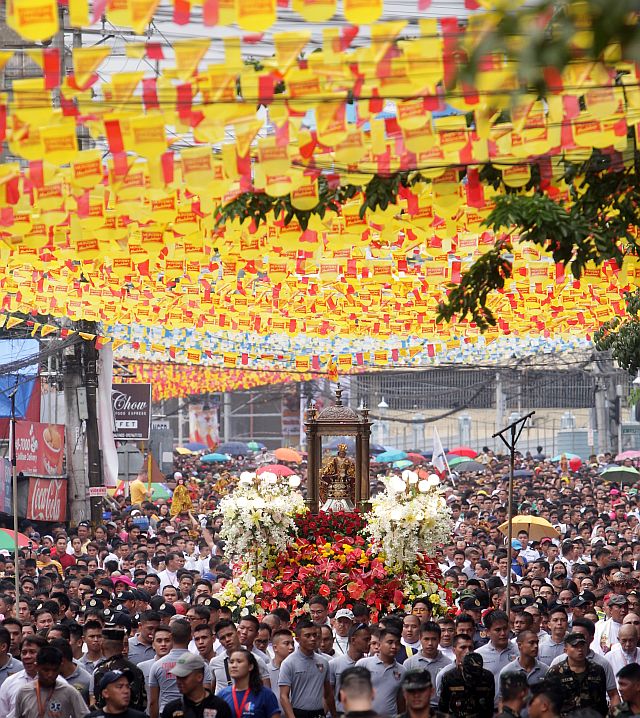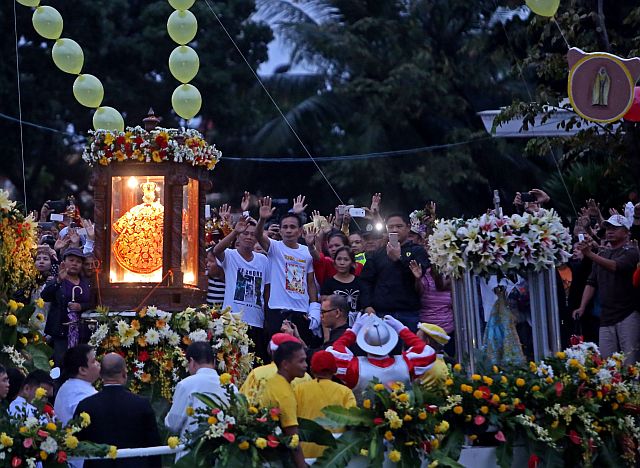About a million join the fluvial and foot processions

With fervor burning, nearly a million people came together to pay homage to a beloved patron, the Señor Santo Niño, in the fluvial and foot processions that marked the eve of the Feast of the Child Jesus that is being celebrated today, the third Sunday of January. (CDN PHOTO/TONEE DESPOJO)
Under overcast skies and incessant drizzle, close to a million people — with fervor burning — lined the streets of Cebu City or joined the solemn foot procession in honor of the Sto. Niño de Cebu.
A wet afternoon and security concerns failed to dissuade devotees from attending the 5.7-kilometer procession that lasted three hours and 20 minutes.
Earlier in the day, thousands of people lined the streets, took part in the Mass and joined the 300-boat fluvial procession along Mactan Channel from the Ouano Wharf to Pier I in Cebu City, where over 30,000 people waited to meet the returning images of the Child Jesus and the Our Lady of Guadalupe. (story on p. 4)
Supt. Ryan Devaras, ground commander of the Cebu City Police Office in yesterday’s prayer walk, said the crowd reached 900,000 based on the length of the procession and the density of the multitudes who were present.
“The solemn procession is generally peaceful,” said Devaras, who was with about 20 policemen who escorted the flower-decked carroza bearing the image of the Sto. Niño during the event.
The crowd was just half of the estimated two million who took part in last year’s solemn procession, but Devaras noted it was not less solemn.
A total of 2,585 policemen and military personnel were deployed along the procession route.
Cebu Archbishop Jose Palma, who traditionally carried the image of the Sto. Niño from its altar inside the Basilica Minore del Santo Niño de Cebu to the carroza outside the church at the start of the procession, was not able to do it yesterday.
Fr. Japheth Geonzon, the archdiocesan liturgical master of ceremonies, said the 66-year-old prelate was not feeling well and opted to rest after he joined the fluvial procession at the Mactan Channel early morning yesterday.
“He has a sore throat and he decided to rest so he can preside over the Pontifical Mass for the feast of the Sto. Niño tomorrow (today, January 15),” Geonzon told Cebu Daily News.

Devotees lining up at the Ouano Wharf wave goodbye as the yacht carrying the sacred images leaves the wharf, signaling the start of the fluvial procession. (CDN PHOTOS/LITO TECSON)
Resilient faith
Fr. Pacifico “Jun” Nohara, OSA, the rector of the centuries-old Basilica, carried the processional image of the Sto. Niño to the carroza in lieu of Palma.
The rector said no rain or storm can dampen the spirit of Sto. Niño devotees.
“Even amid the rain, we are here praising Him. As devotees, nothing can stop us from coming to Him. Pit Senyor!” he said.
The carroza, or carriage, that bore the image of the Holy Child emerged from the Basilica at 1 p.m.
Bells from the newly reconstructed belfry pealed as devotees shouted “Pit Senyor!” and waved their hands up in the air when the ancient hymn for the Sto. Niño, “Bato-Balani sa Gugma,” was sung.
The procession snaked through the city’s main streets down to Fuente Osmeña, General Maxilom Avenue, Imus Road and M.J. Cuenco Avenue before returning to the Basilica at 4:20 p.m.
Another image of the Sto. Niño from San Nicolas Parish known as El Teniente dela Guardia was stationed in a carroza in front of the Basilica during the procession. Traditionally, it guards the Basilica while the Sto. Niño de Cebu is brought out for the procession.
Overflowing emotion
Devotees, many of whom were teary-eyed, waved their hands or uttered prayers as the Sto. Niño carroza passed by.
Some carried statuettes the Sto. Niño, recited the holy rosary in English and Cebuano and sang liturgical hymns which were broadcast on radio and amplified by speakers.
The images of St. Joseph and the Our Lady of Consolation were ahead of the carroza bearing the Sto. Niño.
Despite the prohibition, balloons still greeted the Sto. Niño image.
Confettis, flower petals and doves were also released during the procession.
The carroza was guarded by a human cordon composed of policemen, blue guards, criminology interns and college students under the National Service Training Program who kept the throng of devotees at bay.
A few meters in front of the carroza was the Armed Forces’ Central Command band which played hymns in honor of the Sto. Niño.
After the procession, Palo Archbishop John Du celebrated Mass at the Pilgrim Center, followed by an hour of joyous dancing for a litany of prayer intentions ranging from priests, parents, politicians, the sick, the youth, sinners and the loveless.
Revisiting history
Earlier yesterday, the fluvial procession ended with devotees welcoming the images of the Sto. Niño and the Our Lady of Guadalupe as they arrived at Pier 1 past 7 a.m.
The images were then brought to the Basilica’s Pilgrim Center for a Mass that featured a reenactment of the first Mass, baptism and wedding in Philippine soil.

The yacht carrying images of the Señor Sto. Nino and the Our Lady of Guadalupe leads the fluvial procession. (CDN PHOTO/LITO TECSON)
Men dressed as Spanish soldiers carried on their shoulders the image of the Sto. Niño, accompanied by bare-chested natives in slippers. The image of the Blessed Virgin Mary, on the other hand, was brought by Cebuano natives. Both images were placed on the altar adorned with a variety of flowers.
The soldiers planted Magellan’s wooden cross draped in white cloth beside the altar while the Society of the Angel of Peace choir, led by renowned Cebuano composer Manny Lapingcao, sang a hymn in honor of the Holy Cross.
Nohara, who played the role of Fr. Pedro de Valderrama, the chaplain of Magellan’s fleet, placed incense on the cross. Using a wooden ladle, he then poured holy water on the heads of spouses Filemeno and Annie Pintor, who portrayed the role of pre-Spanish Cebu chieftain Rajah Humabon and his wife Humamay, as well as a group of natives.
Cebu’s Humabon got the baptismal name Carlos while his wife was named Juana.
Priests who concelebrated the Mass also blessed the crowd of about 3,000 devotees with holy water.
In the reenactment of the first wedding, spouses Ildefonso and Aida Rosales portrayed the roles of Don Andres de Calapata and Princess Isabel, the first couple to be wed in Christian rites in the Philippines.
During the Mass offertory, the “natives” offered mangoes, papaya, squash, coconut, guyabano and live chickens.
As baptismal gifts in 1521, Portuguese explorer Ferdinand Magellan gave to Queen Juana the image of the Sto. Niño and a statue of the Blessed Virgin Mary, and the Ecce Homo, a bust of the suffering Christ.
The original icon of the Sto. Niño is venerated in a glass case in a side chapel of the Basilica. The small image of Mary was later found in a well and turned over to the Cebu Cathedral. However, the original image could no longer be located.
After the Mass, Sinulog dances were performed by members of the Cofradia del Sto. Niño, Our Lady of Guadalupe, the late Estelita “Nang Titang” Diola’s dance group from Mabolo and the renowned Sandiego Dance Troupe.
Security
Senior Supt. Joel Doria, CCPO chief, appreciated the public’s cooperation for the tight security and the temporary deactivation of wireless signals.
“The public cooperated. Although they were not used to the zero mobile phone signal, it turned out well since our police have radio units,” Doria said partly in Tagalog.
Disclaimer: The comments uploaded on this site do not necessarily represent or reflect the views of management and owner of Cebudailynews. We reserve the right to exclude comments that we deem to be inconsistent with our editorial standards.
